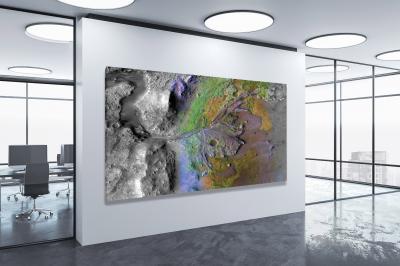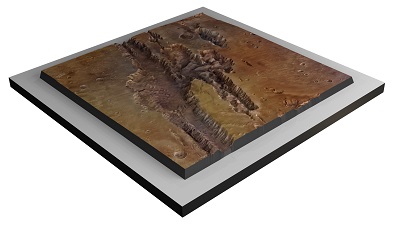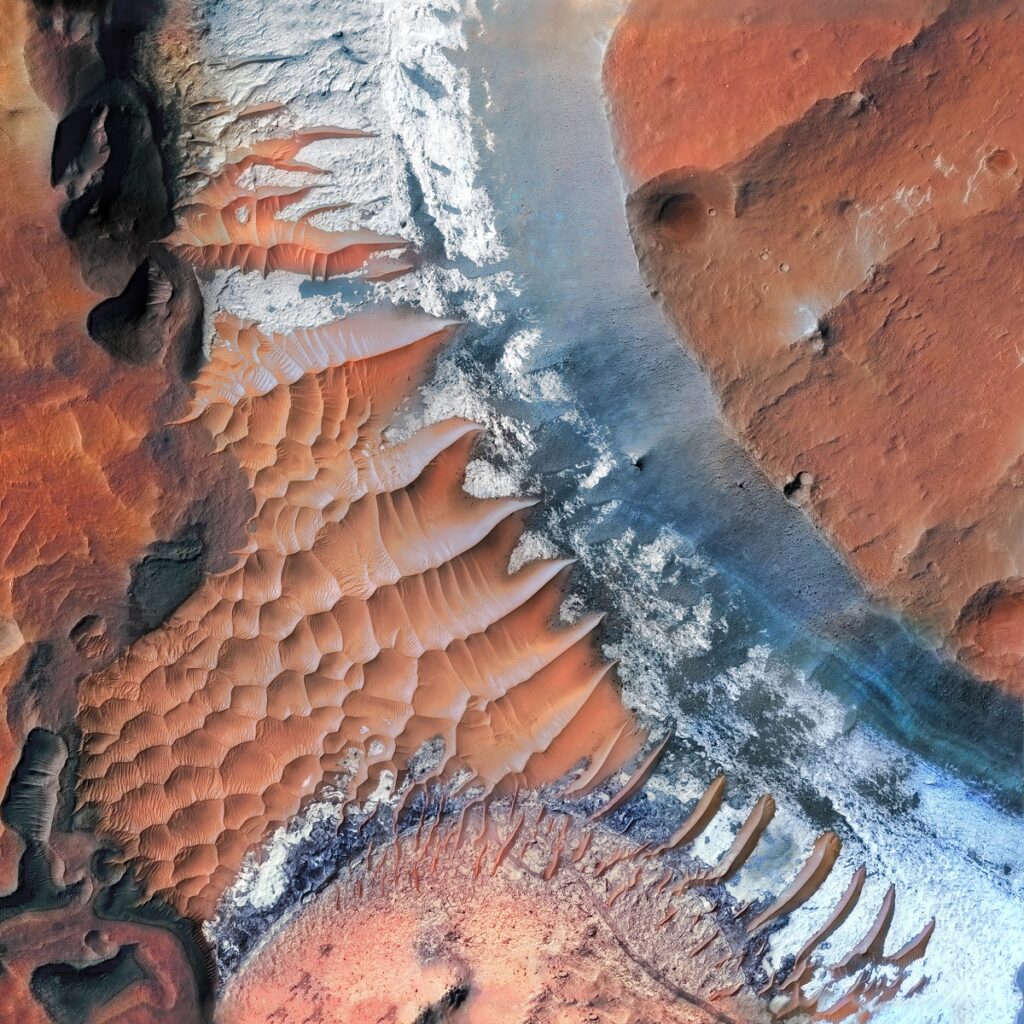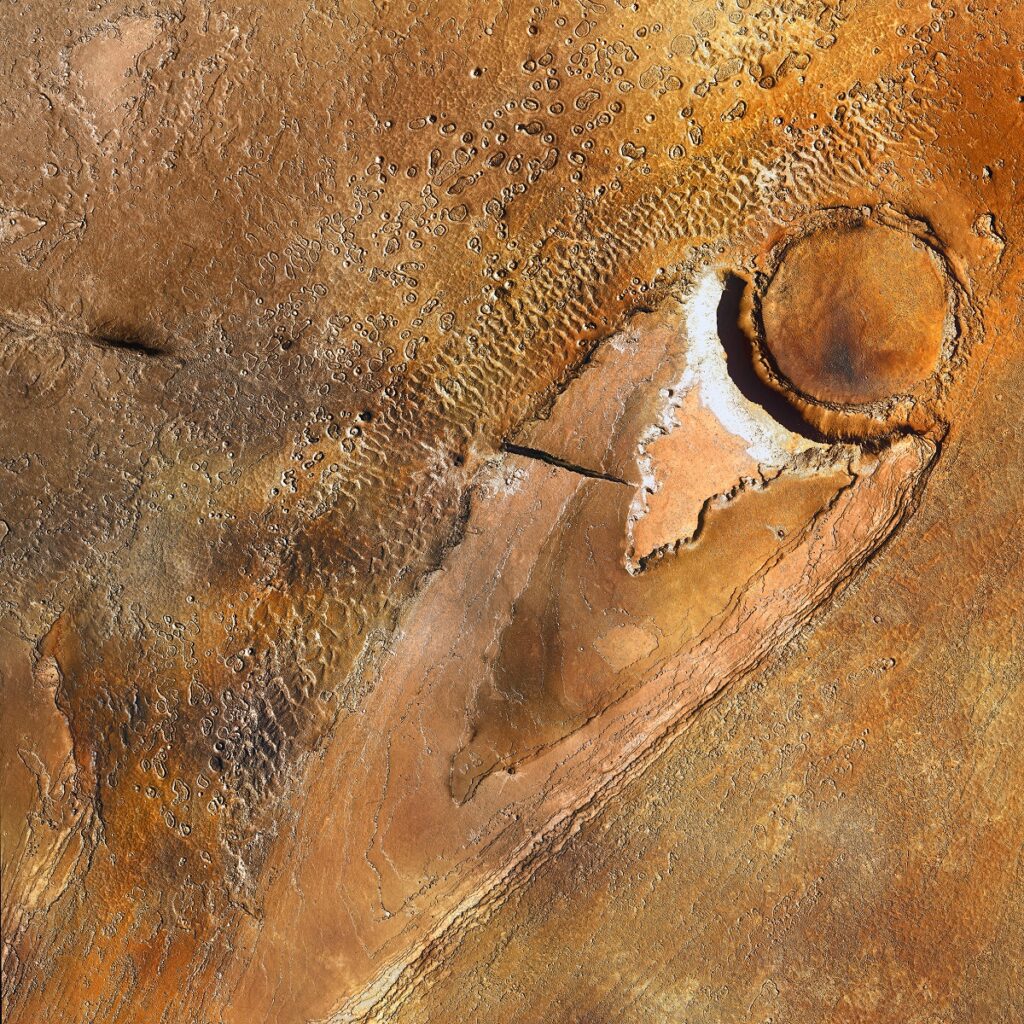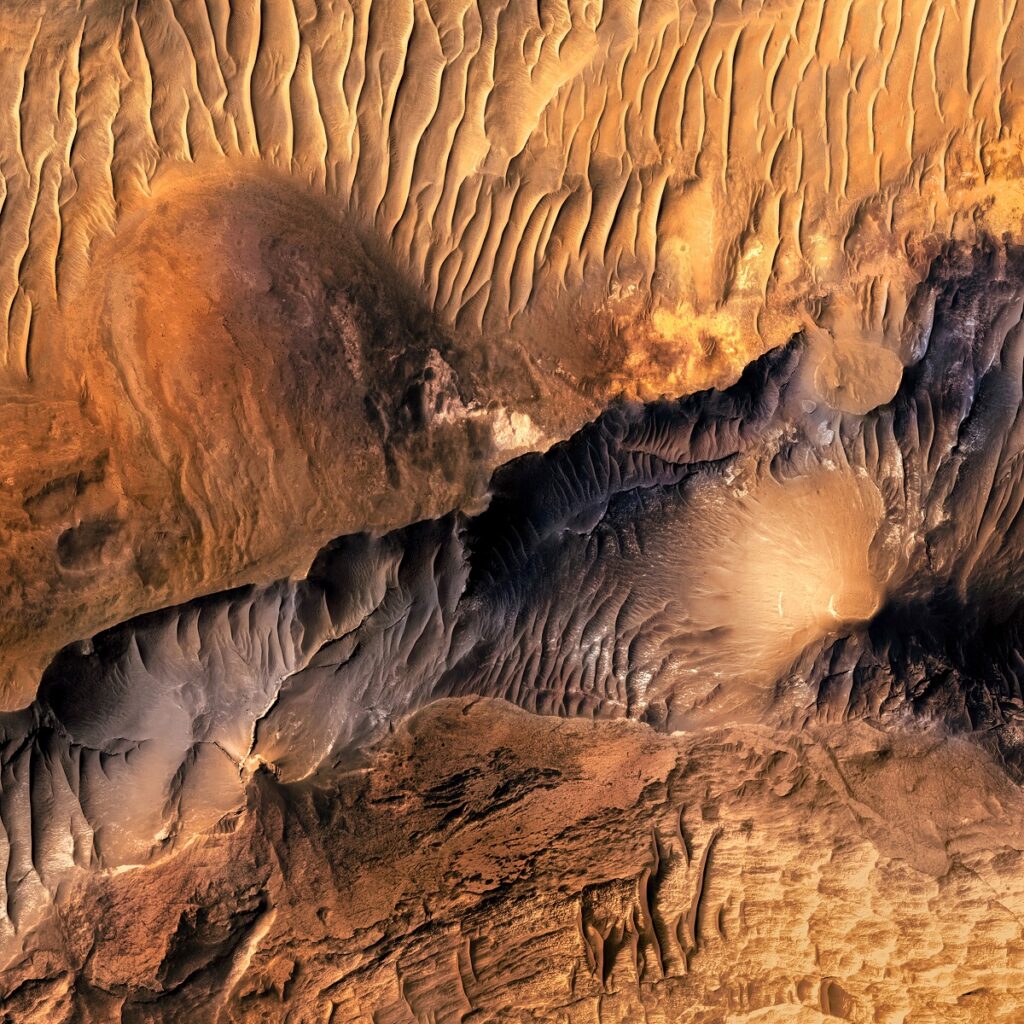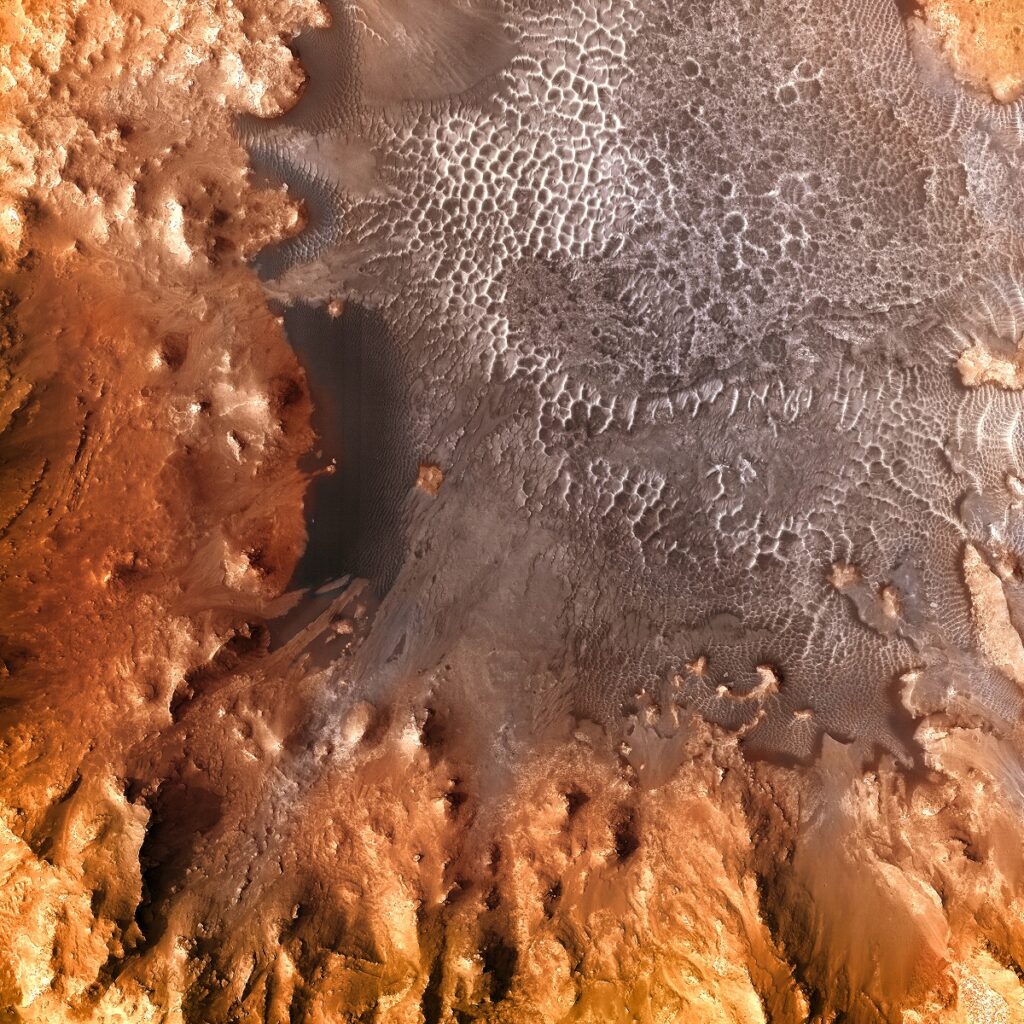Top 10 Largest Craters on Mars
Top 10 Largest Craters on Mars
WhiteClouds Builds 3D Marscapes and Canvas Prints
Fasten your seatbelts, fellow explorers! We’re embarking on a virtual expedition to Mars, home to some of the most gigantic and awe-inspiring craters in the entire solar system. These colossal impact scars tell tales of cosmic collisions, ancient water bodies, and possibly even the conditions for life as we know it. As celestial detectives, scientists painstakingly analyze these craters, drawing connections to Martian history, geology, and the insatiable quest for extraterrestrial life. So, grab your space helmets as we navigate through the top 10 largest craters on Mars.
#1: Hellas Planitia (1,400 Miles)
Taking the undisputed crown as the largest impact basin not only on Mars but across the solar system, Hellas Planitia is an awe-inspiring marvel of geological forces. With an astounding diameter that stretches over 1,400 miles, this enormous crater is nestled within the Martian southern hemisphere. Adding to its astonishing features, the depth of Hellas Planitia plummets almost 7 miles beneath the average surface level of Mars, a depth so profound that scientists speculate it might have once harbored an ancient ocean. Could this be evidence of a past where Mars was more Earth-like, with bodies of water and perhaps even life? In the realm of science fiction, Hellas Planitia frequently takes center stage as a highly desirable landing site for future human expeditions. Authors often imagine colonists exploiting the basin’s potentially resource-rich environment, painting an alluring picture of humanity’s future on the Red Planet.
#2: Argyre Planitia (600 Miles)
Taking the second spot, yet not dimming in its extraordinary features, is the majestic Argyre Planitia. This captivating impact basin flaunts a diameter that spans approximately 600 miles and is situated within the craggy terrain of Mars’ southern highlands. What sets Argyre Planitia apart and places it under the scientific microscope is its remarkably smooth floor. Researchers propose that this flat landscape is most likely the result of sedimentary deposits that have accumulated over time. In the imaginative corridors of literature, especially science fiction, Argyre Planitia is often envisioned as a potential cradle for long-extinct Martian civilizations. The notion draws inspiration from ancient Martian myths that refer to “silver seas,” adding an extra layer of mystique. These legends have been romantically tied to the uniquely smooth, almost silvery surface of the basin, fueling our curiosity and sense of wonder about what mysteries Argyre Planitia may still hold.
#3: Isidis Planitia (600 Miles)
Matching Argyre Planitia in its sheer expanse, Isidis Planitia is a mammoth impact basin stretching across an impressive 600 miles in diameter. Situated strategically near the Martian equator, this vast crater has captivated the attention of astrobiologists, geologists, and space enthusiasts alike. What has made this particular location so intriguing is the discovery of specific minerals that could only form under conditions involving the presence of liquid water, thereby offering tantalizing clues into the planet’s hydrological history and the prospect of past life.
In an ambitious mission to delve deeper into these mysteries, the British-led Beagle 2 Rover was programmed to touch down in this significant crater in 2003. However, the mission faced an unfortunate and dramatic turn of events. Beagle 2 was tragically lost as it arrived on Mars, and for over a decade, its disappearance remained one of space exploration’s most perplexing mysteries. It wasn’t until 2015 that the enigma was finally resolved. High-resolution images from Martian orbiters spotted the wreckage of Beagle 2, finally offering closure on the whereabouts of the long-lost rover. Consequently, while it never got to carry out its original scientific objectives, Isidis Planitia remains a point of keen interest, serving as both a cautionary tale in the annals of space exploration and a beacon calling for future missions to unlock its secrets.
#4: Schiaparelli Crater (286 Miles)
Named in honor of the renowned Italian astronomer Giovanni Schiaparelli, who contributed significantly to our early understanding of the Red Planet, the Schiaparelli crater is a magnificent celestial formation located tantalizingly close to Mars’ equator. The crater boasts a staggering diameter of 286 miles, making it a prominent feature on the Martian surface. A focal point of scientific intrigue, the crater is renowned for its pronounced rays—striking lines of debris that radiate outwards from the central point of impact, telling a tale of its violent formation. The European Space Agency’s ExoMars 2016 mission had its Schiaparelli lander designated to explore this intriguing area in a detailed scientific study. Unfortunately, the lander failed upon its descent to the Martian surface, cutting short its anticipated research. Nevertheless, the crater that bears the Schiaparelli name continues to draw substantial attention from the scientific community.
#5: Lyot Crater (132 Miles)
Lyot Crater, has a diameter of 132 miles. This stunning crater is situated in the northern lowlands of Mars and has garnered attention for its clearly visible ejecta blanket—a layer of material that was expelled during the crater’s formation. Intriguingly, some scientists hypothesize that specific features within Lyot Crater suggest the presence of past glacial activity. If proven true, this could offer an unusual, icy twist to the conventional understanding of Martian geology, further enriching our ever-expanding knowledge of this captivating planetary neighbor.
#6: Newton Crater (103 Miles)
Sitting at a diameter of 103 miles, Newton Crater is a distinct landmark in the Noachis Terra region, one of the oldest known terrains on Mars. The crater walls display eroded gullies that have caught the eyes of scientists. These gullies offer potential evidence of past water flow on the Martian surface. As such, Newton Crater is seen as a cornerstone in the broader understanding of Martian geological phenomena, a subject that continues to fascinate and puzzle researchers.
#7: Gusev Crater (100 Miles)
Occupying a space of approximately 100 miles in diameter, Gusev Crater is a bewildering Martian formation that scientists have speculated could have once served as a basin for a Martian lake. NASA’s Spirit Rover was dispatched to explore this potentially water-filled past when it landed on the crater in 2004. Over the course of five years, the rover scoured the landscape but unfortunately found scant evidence to support the theory of prolonged water presence. Despite this, Gusev Crater continues to be a critical element in the intricate puzzle that is Mars’ geological and hydrological history.
#8: Gale Crater (96 Miles)
‘While Gale Crater may not rank among the most massive craters on the Martian landscape, it more than earns its stripes due to its profound scientific significance. Measuring 96 miles in diameter, this awe-inspiring crater is the proud home to Mount Sharp, an imposing mountain whose sediment layers function as a fascinating window into the geological and climate history of Mars. NASA’s Curiosity Rover has been diligently exploring the intricacies of this area since its landing in 2012. Over the years, the rover has made a plethora of groundbreaking discoveries that have offered unprecedented insights into the past habitability and climatic conditions of Mars, firmly placing Gale Crater at the forefront of Martian scientific exploration.
#9: Eberswalde Crater (40 Miles)
Although smaller in scale with a diameter of just 40 miles, Eberswalde Crater stands out for housing a remarkably well-preserved river delta. This unique feature strongly suggests that the crater was once the location of a significant lake. With its compelling geological attributes, Eberswalde Crater is considered a high-priority target for future Martian exploration missions. It offers a tantalizing glimpse into what Mars’ aqueous past could have been like, making it an invaluable natural laboratory for scientists.
#10: Utopia Planitia (2,000 Miles)
While not technically classified as a crater, Utopia Planitia more than earns its spot on our list due to its staggering dimensions. This sprawling impact basin stretches an almost incomprehensible 2,000 miles in diameter, making it one of the largest known formations of its kind on the Martian surface. Its name, “Utopia Planitia,” translates evocatively to “Plains of Paradise,” capturing the imagination and fueling speculation about what this vast expanse might have to offer.
This otherworldly plains area holds historical significance as well. It served as the landing site for the Viking 2 Lander, one of humanity’s early forays into interplanetary exploration, which successfully touched down on the Martian surface in 1976. This monumental event marked one of the early milestones in human history’s venture into deep space, providing critical data that continues to inform our understanding of Mars.
Because of its sheer size and relatively flat terrain, Utopia Planitia is often considered a prime candidate for future human settlements on Mars. It is envisioned as a location where mankind could one day build colonies, conduct extensive research, and perhaps even establish a new frontier for human civilization. The potential for discovering valuable resources in this expansive basin adds yet another layer of fascination and promise, making Utopia Planitia a focal point for both scientific inquiry and the collective dreams of humanity’s multi-planetary future.
As we bring this captivating journey across the Red Planet’s top 10 largest craters on mars to a close, it becomes increasingly clear that each crater is more than just a geological feature; it serves as a celestial historian, each narrating its own unique chapter in the grand cosmic saga that is the history of Mars. These craters are far more than mere indentations or dents in the Martian terrain. They function as rich, multi-layered repositories, packed full of tantalizing geological secrets, and perhaps even hidden biological mysteries waiting to be unearthed. These ancient formations beckon not just scientists but also the wider public imagination. They call out to us, urging us to delve deeper, explore further, and dream bigger about what lies beyond our home planet, reminding us that Mars, with its seemingly barren landscape, is a planet full of stories, yet to be fully discovered and understood.
Check out our 3D Mars Learning Center for more information on Mars and its largest craters. You can also learn more at: NASA Mars Exploration.
More About Mars
Contact us today to learn more about our 3D services and how we can help you achieve your goals.
